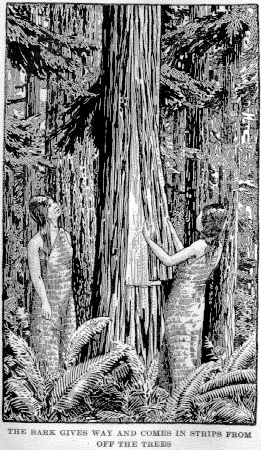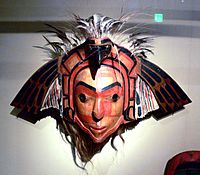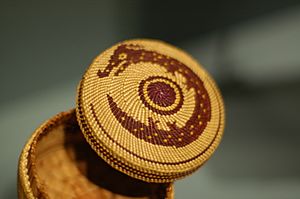Nuu-chah-nulth facts for kids

Three Nuu-chah-nulth children in Yuquot, 1930s
|
|
| Total population | |
|---|---|
| In 2016 (4,310) people identified having Nuu-chah-nulth ancestry | |
| Regions with significant populations | |
| Canada (British Columbia) | |
| Languages | |
| Nuu-chah-nulth, English, French | |
| Related ethnic groups | |
| Kwakwaka'wakw, Makah; other Wakashan-speaking peoples |
The Nuu-chah-nulth (pronounced noo-CHA-nulth) are one of the many Indigenous peoples of the Pacific Northwest Coast in Canada. They were once called the Nootka. The name Nuu-chah-nulth describes fifteen related tribes. Their traditional home is on the west coast of Vancouver Island in British Columbia.
Long ago, there were many more Nuu-chah-nulth tribes. But diseases like smallpox and the arrival of settlers caused some groups to disappear. Others joined nearby tribes. The Nuu-chah-nulth are related to the Kwakwakaʼwakw, the Haisla, and the Ditidaht First Nation. Their language, Nuu-chah-nulth, is part of the Wakashan language family.
The main group that represents these tribes today is called the Nuu-chah-nulth Tribal Council.
Contents
History of the Nuu-chah-nulth

First Meetings with Europeans
In 1778, a British explorer named James Cook met villagers at Yuquot. They told him to "come around" with his ship to the harbour. The Nuu-chah-nulth word for "to circle around" is nuutkaa. Cook thought this was the name of the inlet, which is now called Nootka Sound. The name "Nootka" was then used for the people living there.
The Nuu-chah-nulth were among the first Indigenous peoples in the Pacific Northwest to meet Europeans. Europeans came to their area to trade, especially for furs. Around 1790, Spain and Great Britain argued over who controlled Nootka Sound. This disagreement was called the Nootka Crisis. It was settled when Spain agreed to give up its claims to the North Pacific coast. Maquinna, a powerful chief of the Mowachaht Nuu-chah-nulth, helped with the talks to settle this dispute.
A few years later, in 1803, Chief Maquinna and his warriors captured an American trading ship called the Boston. They killed most of the crew but kept two men as prisoners. One of these men, John R. Jewitt, later wrote a book about his almost three years living with the Nuu-chah-nulth. He eventually escaped with help from another chief.
In 1811, another trading ship, the Tonquin, was attacked in Clayoquot Sound. Warriors from the Tla-o-qui-aht tribe attacked the ship because its captain had insulted them. Most of the crew were killed. The next day, warriors went back on the ship to take things from it. But a crew member who was hiding set fire to the ship's gunpowder. The explosion killed many First Nation people.
From the first meetings with Europeans until about 1830, more than 90% of the Nuu-chah-nulth people died. This was mainly due to new diseases like malaria and smallpox. Europeans had some protection from these diseases, but the First Nations did not. This caused great sadness and changes in their communities. By the early 1900s, their population was about 3,500.
The 20th Century and Beyond
In 1979, the tribes on western Vancouver Island chose the name Nuu-chah-nulth. This name means "all along the mountains and sea." They chose this name to unite themselves. They had formed an alliance in 1958 to speak with one voice to the government and other groups. In 1985, the government of British Columbia allowed the Nuu-chah-nulth to manage their own Child Welfare Services. This made them the first Indigenous group in British Columbia to do so. The Makah people in northwest Washington are closely related to the Nuu-chah-nulth.
Nuu-chah-nulth Tribes
Today, there are 13 recognized Nuu-chah-nulth band governments. Here are some of them:
- Ahousaht First Nation: This is a large group with over 2,000 people.
- Ehattesaht First Nation: (population 294)
- Hesquiaht First Nation: (population 653)
- Kyuquot/Cheklesahht First Nation: (population 486)
- Mowachaht/Muchalaht First Nations: (population 520) They were once known as the Nootka band.
- Nuchatlaht First Nation: (population 165)
- Huu-ay-aht First Nation: (population 598)
- Hupacasath First Nation: (population 256)
- Tla-o-qui-aht First Nations: (population 881)
- Toquaht First Nation: (population 117)
- Tseshaht First Nation: (population 1002)
- Uchucklesaht First Nation: (population 181)
- Yuułuʔiłʔatḥ (Ucluelet First Nation): (population 606)
In 2006, the total population for these 13 tribes was 8,147 people. The Ditidaht First Nation and the Pacheedaht First Nation are also related but are not part of the Nuu-chah-nulth Tribal Council.
Nuu-chah-nulth Culture
Whaling Traditions
The Nuu-chah-nulth were one of the few Indigenous groups on the Pacific Coast who hunted whales. Whaling was very important to their culture and beliefs. It is seen in their stories, songs, names, and family histories.
Evidence shows that the Nuu-chah-nulth have hunted whales for over 4,000 years. They hunted whales for their blubber (fat) and meat. They often caught grey or humpback whales. These whales were calmer and came closer to the shore. Sometimes, they even hunted orcas to show bravery, even though it was very dangerous. Orca meat and blubber were thought to be very special.
Whaling provided important food and oil. It also played a big role in their social life. The chief would lead the whale hunt, joined by other important community members. Each Nuu-chah-nulth community had its own special traditions and ceremonies for whaling. These included ceremonial bathing, prayer, and other rituals done before and after the hunt. The chief and his wife would perform these ceremonies. They believed these rituals helped decide if the hunt would be successful. A chief's social status also affected who could join the hunt and how the whale's meat and blubber were shared.
A famous Nuu-chah-nulth artifact is the Yuquot Whalers' Shrine. This was a special building used for spiritual preparations before whale hunts. It had carvings of spirit figures and bones of whaling ancestors. Today, it is kept at the American Museum of Natural History in New York City. The Mowachaht First Nation is working to bring these sacred items back home.
Traditional Foods
While whaling was important, the Nuu-chah-nulth also had many other food sources from the ocean and land. From the ocean, they caught fish like halibut, herring, and salmon. They also gathered clams, sea urchins, and mussels from the shore at low tide. Salmon streams were cared for to make sure there were always enough fish. Salmon was cooked in large wooden pots with hot stones or dried for winter.
From the land, they gathered plants like camas root, fern roots, and many types of berries such as blueberries and huckleberries. Some Nuu-chah-nulth groups also grew camas root and crabapple trees for food.
Elders passed down their knowledge of where and when to find these foods to younger generations. This was done through stories and by teaching children how to gather resources from a young age.
To help bring back traditional eating habits, the Nuu-chah-nulth Tribal Council and sixteen tribes created a cookbook. This cookbook, called Čamus (chum-us), has 90 pages of traditional recipes. It focuses on foods from the west coast of Vancouver Island and northern Washington. It shares cooking tips, cultural notes, and old stories. Čamus teaches about traditional ways of eating and living a healthy life.
Cedar Tree Use
The Nuu-chah-nulth also used wood and bark from red and yellow cedar trees. These trees were used for building homes and making many different items. Artists carved large logs into totem poles and ocean-going canoes. The bark was pulled into strips and softened in water. Then, it was woven into baskets, clothing, and special ceremonial outfits.
Social Structure
Because there was so much food and other resources, Nuu-chah-nulth communities developed a clear social structure. There were commoners and chiefs. Commoners had some freedom, but they needed the chief's permission to fish, hunt, or gather food in the community's territory.
Chiefs controlled ceremonial and land rights. They were also in charge of sharing wealth within their communities. A chief's status depended on how well they could provide for their people. By managing how resources were used, chiefs kept the social order and made sure resources stayed strong for the future.
Potlatch Ceremonies
The Nuu-chah-nulth and other Pacific Northwest cultures are famous for their potlatch ceremonies. In a potlatch, the host gives many generous gifts to their guests. The word 'potlatch' comes from a Nuu-chah-nulth word. Potlatches have many purposes. They help share wealth, show and keep social status, strengthen friendships, celebrate marriages, and remember important events.
Notable people
- Samuel Haiyupis, a famous carver
See also
 In Spanish: Nuu-chah-nulth para niños
In Spanish: Nuu-chah-nulth para niños
- Uu-a-thluk, an organization that manages aquatic resources




